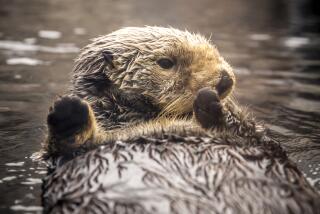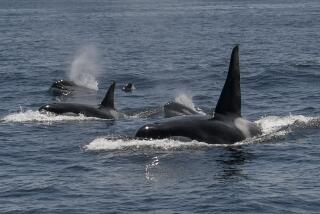One of SeaWorld’s oldest killer whales dies
- Share via
Kasatka, a 42-year-old killer whale that SeaWorld calls the matriarch of its orca family, died Tuesday night, marking the second orca death in a month at the marine parks.
The orca’s passing at SeaWorld San Diego followed years-long treatment for lung disease. In recent days, Kasatka’s health and appetite had declined significantly despite specialized treatments, and veterinarians euthanized her to “prevent compromising her quality of life,” SeaWorld said Wednesday.
A mother of four, grandmother of six and great grandmother of two, Kasatka died at approximately 8:15 p.m. Tuesday surrounded by members of her pod, as well as veterinarians and caretakers, SeaWorld said.
“I have spent the past several years with Kasatka and was truly blessed to be part of her life,” said Kristi Burtis, orca behaviorist. “Although I am heartbroken, I am grateful for the special time we had together and for the difference she has made for wild orcas by all that we have learned from her.”
Kasatka is believed to be the second oldest of all the whales in SeaWorld marine parks. The oldest is Corky, a female orca living at the San Diego park who is believed to be 53.
Just last month, Kyara, a 3-month-old killer whale born at SeaWorld San Antonio, died after suffering from pneumonia. The exact cause of death has yet to be released by SeaWorld.
The calf was the final orca born in captivity at a SeaWorld park. Orlando-based SeaWorld Entertainment announced early last year that it would immediately stop breeding orcas following years of animal rights protests and declining attendance.
In January, one of SeaWorld’s most widely known whales, Tilikum, believed to be 36, died at the Orlando park. The orca, responsible for the 2010 drowning death of trainer Dawn Brancheau, was the centerpiece of the 2013 documentary “Blackfish,” which was critical of SeaWorld’s treatment of its killer whales.
In its blog post announcing Kasatka’s death, SeaWorld said the type of bacterial respiratory condition that the orca was suffering from is considered the most common cause of mortality and illness in whales and dolphins, both in the wild and in zoological facilities.
One of the last killer whales to come to SeaWorld from the wild, Kasatka was captured near Iceland in 1978.
PETA, which has been critical of SeaWorld for years and has called for the parks to release their captive orcas to seaside pens, said it will be holding a memorial Wednesday for Kasatka.
“The dead bodies at SeaWorld are stacking up about as fast as its stock is falling, with Kasatka dead just a few weeks after the death of her 3-month-old granddaughter,” said Tracy Reiman, executive vice president of the People for the Ethical Treatment of Animals.
Across SeaWorld’s U.S. and overseas parks, there are 33 killer whales, almost all born in captivity. SeaWorld San Diego now has 10 orcas.
Last week, SeaWorld Entertainment posted a net loss for the second quarter of nearly $176 million and acknowledged that its attendance continues to decline, blaming the slump in San Diego on the reemergence of its “public perception issues” after having cut back on marketing efforts to bolster its reputation.
Weisberg writes for the San Diego Union-Tribune.
More to Read
Inside the business of entertainment
The Wide Shot brings you news, analysis and insights on everything from streaming wars to production — and what it all means for the future.
You may occasionally receive promotional content from the Los Angeles Times.











